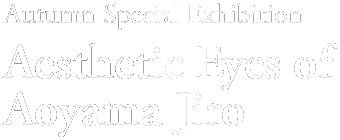

Shirasu commented, “Whether a person or ceramic ware a spirit hides in a place
that cannot be seen. But if [a spirit] really exists, it cannot but appear in some shape
or form—This was Aoyama Jiro’s belief ” (Shirasu, Ima naze Aoyama Jiro nanoka? (Why
is it Aoyama Jiro now?), Tokyo: Shinchosha, 1999). “What is admirable about Aoyama-san
is that he sought the spirit within everything, from ceramic ware made for appreciation,
which can be understood by looking at a photo of it, to the essence of ceramics that
could not be understood by seeing a photo” (ibid).

Kobayashi Hideo put all his energy into finding the spirit of antiques with Aoyama,
before and after World War II, as a result, his style became energetic. Kobayashi divulged
to the novelist Ibuse Masaji (1898-1993) that he was able to understand literature
because of his obsession with antiques. In a discussion after the war, Kobayashi said,
“Beauty penetrates truth and perhaps good as well.” With the strength of his pen, he
demonstrated the power of beauty conferred in life and literature.

In his mid-teens, Aoyama started buying rare Chinese ceramics. In his twenties,
he was involved with initiation of all the important art movements related to the
appreciation of ceramics, Mingei (folk art), and Yi-dynasty decorative arts, published
fine photography books, and haply started the trend of ceramics appreciation,
which continues to this day. Aoyama headed “Aoyama Gakuin” or Aoyama School, where many of prominent members of the Showa-period (1926-1989)
literary circle—starting with Kobayashi Hideo, the critic Kawakami Tetsutaro (1902-80),
the novelist Nagai Tatsuo (1904-90), the poet Nakahara Chuya (1907-37),
Ooka Shohei (1909-88), and author Kon Hidemi (1903-84)—studied.
Aoyama’s “eye” made Kobayashi say, “We were brilliant students, but he
was a genius.” Not only was he a prolific writer, Aoyama was also involved
with producing over two thousand book covers for which he called himself the
“humane book binder.” In 1979, he died at the age of seventy-seven, without
ever having held a single profession. Kawakami Tetsutaro, who mastered
Aoyama’s school of thought, recollects that Aoyama appraised and critiqued
society with the same eye and the same modus operandi as he did antiques and
people’s personalities, and called Aoyama an exceptional critic of culture
and civilization. |

